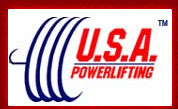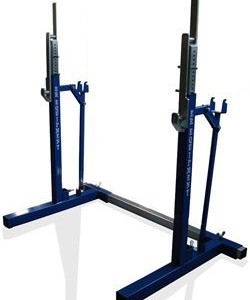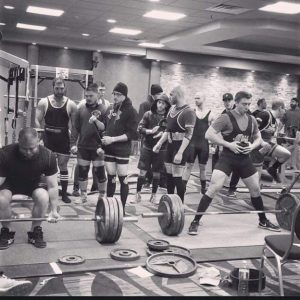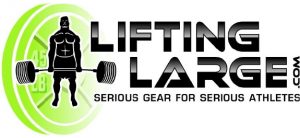First things first, you have to actually sign up for a meet to begin preparing. If you’re looking for help on how to find a meet, click here. Just do it. Seriously.
If you’re worried about whether or not you’re “strong enough” to do your first meet, keep in mind that VAST majority of local meets are made up by beginners. I can 100% guarantee you will not be the only person there who is doing their first meet. This is such a common hang-up for people, but the reality is that you will never be “strong enough” to do your first meet. The number will just keep changing as you get stronger.
Not only that, but you’ll actually slow down your progress towards “strong enough” if you DON’T compete. Meets are like adding deadlines to your strength goals. The keep you accountable in terms of lifting to the proper standards and they FORCE you to see if you’ve actually improved under stable conditions. Failing to see any improvements at a meet can often be the impetus for major changes to your strategy that really propel you toward new heights in Powerlifting.
Again, go find a meet and sign-up.

I recommend the USAPL for drug-free competitors in the United States. Click to find a USAPL meet near you.
The Golden Rule of Meet Preparation
If I could boil down all of meet preparation into one rule of thumb, it would be the following: don’t try new things on meet day. This is ESPECIALLY true if it is your first meet. You’re already going to be nervous and going through a ton of overwhelming experiences and emotions. There is absolutely no reason to complicate any of this further by trying out a new warm-up routine, cutting water weight for the first time, using new equipment, making a last-minute technique change, or eating some super-secret performance enhancing foods that you never normally eat.
If anything, you should be trying to make the meet conditions as similar to your training as is humanly possible. If you’re having doubts about something, remember that suggestion and you’ll probably make the right choice.
Before the Meet…
Here’s somethings to do and consider before you ever get to the meet.
Brush up on the Rules
Federations tend to have mostly the same rules, but you CAN and WILL fail lifts if you’re completely unaware of the specifics of your federation or if you don’t know the general rules of powerlifting. Check out all of our articles on powerlifting rules to make sure you know the rules for all three lifts.
Equipment to Bring
Of course, you’re going to want to bring all of your normal training equipment including your: belt, knee sleeves or knee wraps, wrist wraps, shoes for each lift, and chalk (sometimes meets don’t have high quality chalk). Additionally, you’ll need a plain t-shirt without offensive language (required for squat and bench), a singlet, knee-high socks (required for deadlifts), non-supportive underwear without legs (yes, seriously), and I’d also recommend bringing a bottle of baby powder for deadlifts. Baby powder reduces friction against the legs which can help you pull a little bit more weight.
Remember, every federation has different rules about what gear is allowed and what gear isn’t allowed. If you have questions about whether or not your gear is legal, I’d highly recommend checking your federation’s rules directly, but you can also check out our extensive collection of articles covering every single rule: equipment and rules.
Identification, Paperwork, Money
Almost all federations require that you also purchase a membership prior to competing in one of their meets. Sometimes, you’re allowed to do that at the meet itself, but, more often than not, you’re going to be required to purchase that membership before you’re even allowed to sign-up for a meet. You’re going to need proof of membership as well as some kind of photo identification when you check-in at the meet. Either bring a printed copy of your membership or make sure you heavy ready access to it on your phone.

One of my old USAPL Membership cards. Key personal info removed, obviously.
Food, Drink, and Supplements
Remember, the golden rule of meet preparation is to keep things as similar as possible to your normal training. This is NOT the time to eat a bunch of new foods and start downing weird energy drinks that you’ve never had before. Do NOT be that person. I hate to be too graphic, but you very well could find yourself spending more time on the toilet than on the platform if you ignore this advice.
If you’re cutting weight, the nutritional advice is a completely different beast and well outside the scope of this article, but I’ve written about it elsewhere. That said, you should NOT cut weight at your first meet. Your first meet is not the time to introduce such a huge variable. However, there are still some things you can do to be more successful on meet day with your nutrition.
First, if you take preworkout, take your usual amount when you begin warming up for squats (or whatever your routine is). In some smaller federations, meets can last all day but that pretty much doesn’t happen anymore if you compete in the more reputable federations such as the USAPL/IPF or the USPA/IPL. If you’re in a smaller fed, you might want to re-up on your preworkout again before deadlifts if 4+ hours have passed.
Second, you’re going to want to focus on high carb, high sodium meals with low fat content and only moderate amounts of protein. You’re going to want to limit protein and fat content because both macronutrients fill you up and tend to decrease digestion rates. You want those high carb, high sodium meals digested quickly to keep your energy levels up during the meet. If I was forced to give concrete recommendations, I would say eat 100-150g of carbs, 15-25g of protein, and less than 10g of fat every 2-3 hours during your meet. People typically eat things like rice crispies, bagels, bread, and other high-carb, low-fat food sources. Feel free to salt things liberally.
Like I said, most meets don’t last all day anymore so you really only need to eat one solid meal after you weigh-in and then you can just eat snacks until the meet is over. The last thing you want to do is gorge yourself with tons of food and feel awful for four or five hours. It isn’t necessary. Would you eat multiple meals during a three-hour training session? No, you wouldn’t. There’s no need to do it at a meet.
For drinks, don’t overcomplicate things. Make sure you have plenty of water and get some Gatorade, Pedialyte, coconut water, or some kind of electrolyte-heavy drink. The content and amount of what you drink is far more important if you’re cutting weight, but, again, I’ve written about that elsewhere. If you’re not cutting weight, just get some Gatorade powder and some water and you should be good to go.
Before the Meet Starts…
The following is a list of things you’ll need or want to do once you’re at the meet.
Check-In
As I mentioned earlier, when you first get to the venue, make sure you go check-in. You’ll need your photo ID and proof of membership. Usually, this is where you’ll get your attempt card.
Equipment Check
You’ll also need to get your equipment checked to make sure everything is legal. This usually only takes a minute or two. More often than not, the equipment check is right next to check-in. If you’re not sure, just ask and they’ll point you in the right direction.
Rack Heights
The next step is to find your rack height for squat and bench. When you get to the meet, you’ll usually see a group of lifters surrounding the competition rack. Just go over there, get in line, and, when it is your turn, figure out what height you want the rack set to for squats. Make sure to write down the proper rack height on your attempt card that you got from check-in. After a while, when everyone has gotten their squat rack height, they’ll usually switch to bench and you’ll get your bench rack height figured out as well. Sometimes, certain meets do this AFTER squats. When you’re getting your squat height, just ask if they’ll be doing bench height next. The whole point of all of this is to ensure that everyone has the rack set to the proper height when they do their attempts during the meet. It just ensures things run a little more smoothly and quickly.

Basically, just go find this thing and make sure you figure out the correct settings for YOU.
Openers
Once you have your rack heights figured out, you’ll need to figure out your openers. Now, if you don’t know how to pick attempts at a powerlifting meet, check out our article on the subject. Assuming you do know your openers, make sure you convert them to kilos and write them down on the attempt card. From there, go turn in your attempt card to the scorer’s table. They will enter in your numbers for you and this will ensure everyone is the proper order once the meet starts. Some federations or meets require you submit your openers in advance. If you’re unsure or confused about anything, just ask for help. I assure you all the more experienced lifters and the meet staff will be happy to make sure you’re doing things correctly.
Rules Briefing
The last thing that happens before the meet starts is a Rules’ Briefing. It is always a good idea to attend that meeting just so you’re 100% sure you know all the rules for each lift. You’ll be allowed to ask questions and you should walk away from the meeting with absolute clarity on what is legal and what isn’t for each lift. As you get more experienced, you might skip these, but don’t do it at your first meet. The reminders will be helpful to calm your nerves if nothing else.
During The Meet
As the heading implies here, these are all suggestions to help you once the meet has actually started.
Timing Warm-ups
One of the more challenging logistical aspects of competing in a meet is timing your warm-ups. There are a number of factors to consider. First, you need to know what flight you’re in.
If you’re in the first flight, you can just use the meet start time as your gauge. If you typically take 30 minutes to warm-up for squats, start warming up about 30 minutes from the start time of the meet. Do keep in mind that you’ll need to share a bar with other people in the back room. You can’t have a bar all to yourself. This can complicate your typical warm-up a bit. It isn’t that big of a deal in the end, but you need to be aware of this.

This is a typical warm-up room: tons of people sharing a few bars. Credit: Adam Pine
If you’re in a second or third flight, things can get tricky in terms of timing. For an average sized meet of 50 lifters or so, I typically recommend starting your warm-ups after the first flight has finished all of their openers. However, if the meet is HUGE or super tiny, you’ll need to adjust. Bryce Lewis has a GREAT spreadsheet that helps you with all of this and I’d recommend it highly if you’re nervous about warm-up timing.
Attempt Selection
For specifics on attempt selection, check out our article on the topic. Other than that, if you don’t have a coach or handler, try to get someone to film your attempts for you. This way, you can get the objective feedback of bar speed on the video versus just relying on “how heavy it felt”.
General Mindset
Out of the dozens and dozens of meets I’ve been to, I’ve seen people have truly perfect days only a handful of times. You will face some adversity. You’ll probably miss a lift. If you dwell on it for the rest of the meet, it can ruin your mood, your next lift, and even your whole experience. Judges make bad calls, meets are held in poor conditions (super hot/cold), and things happen that you just can’t control. Focus on yourself and focus on what you to have to do next. Stay in the moment and don’t let one misstep get you down.
As a final tip, make sure you’re relaxing between lifts as much as possible. While meets don’t last as long as they used to, you can still expect to be there for anywhere from four to six hours in most cases. If you’re on the edge of your seat, hyped up and anxious the entire time, you’re going to burn out. I’ve seen it countless times. Between lifts, relax, be happy, and have fun.
Once a particular lift starts, you want to be razor focused the entire time. Don’t goof off between attempts. Stay focused on what comes next. Focus on what you need to do execute a perfect rep. Once that third attempt is finished though, go right back to relaxing and regaining your emotional and mental energy.
Meet Preparation Checklist
- Brush up on the rules for:
a) Equipment
b) Technical execution of each lift - What to bring:
i) Paperwork: Membership Proof, Photo ID
ii) All Legal Training Equipment: knee sleeves/knee wraps, wrist wraps, belt, chalk, shoes
iii) Meet Gear: knee-high socks, cotton t-shirt, legless underwear,baby powder, and a singlet
iv) Food: high-carb, high-sodium, low-fat foods that you eat in everyday life already
v) Drink: Water jug and an electrolyte drink such as Gatorade powder
vi) Supplements: Preworkout if you take it - At The Meet:
i) Check-in
ii) Gear check
iii) Get your Squat/Bench Rack Height
iv) Turn in openers to scorer’s table
v) Attend the rules brief - During The Meet:
i) Time Your Warm-ups properly
ii) Follow your Attempt Plan! Film your Attempts
iii) Relax, have fun between Lifts; Stay FOCUSED between Attempts
I hope you kill it at your next meet!
